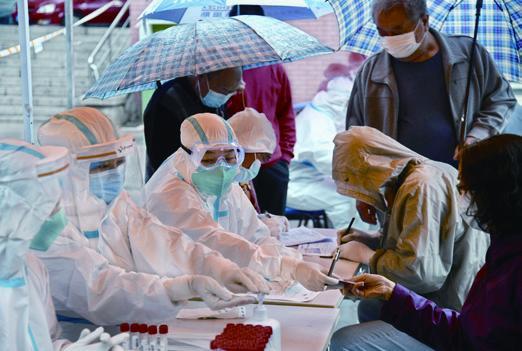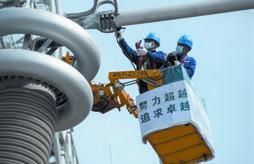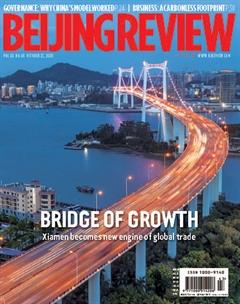COMPREHENSIVE TESTING

People wait to take the novel coronavirus disease (COVID-19) test at a square in Qingdao, Shandong Province in east China, on October 14.
Over 10.75 million people had their throat swabs taken for nucleic acid testing by October 16. Qingdao began city-wide COVID-19 testing on October 12 as the virus re-emerged in the city over the weekend. As of October 16, there were 12 confi rmed cases, the municipal health commission said.

Path to Progress
An aerial view of rural roads in the city of Zunyi in Guizhou Province, southwest China. The drive to build roads in recent years has resulted in all villages in the area getting hardened roads.
Conviction Age
Lawmakers are mulling lowering the minimum conviction age for offenders to 12 under specifi c circumstances.
The proposal was made in a draft amendment to the Criminal Law. The amendment was submitted to the Standing Committee of the National Peoples Congress, the top legislature, on October 13.
If a juvenile who has reached the age of 12 but is under 14 commits intentional homicide or infl icts an injury that leads to death under fl agrant circumstances, he or she shall bear criminal responsibility upon attestation and approval of the Supreme Peoples Procuratorate(SPP), according to the draft amendment.
Currently, minors under the age of 14 do not bear any criminal responsibility in China. However, some high-profi le cases of violent crimes committed by underage youths in recent years have sparked a heated debate on the minimum age of criminal liability.
There has been a rebound in juvenile delinquency in recent years, according to a white paper issued by the SPP.
The draft amendment also adds provisions to strengthen the protection of minors from sexual abuse.
It stipulates that guardians and those who adopt girls aged between 14 and 16 shall be investigated to see if they have engaged in criminal sexual activity with the adopted youngsters. Doctors and teachers for juveniles will also come under the ambit of investigation.
National Park
The Qinling Mountain nature reserve, a natural boundary between Chinas north and south, will be upgraded into a national park by 2025, Xinhua News Agency reported on October 13, quoting the forestry authority of Shaanxi Province in northwest China.
The Qinling National Park will include the core ecological areas of the mountains.
Dang Shuangren, Director of the Shaanxi Forestry and Grassland Bureau, said the national park will highlight Qinlings role as Chinas central water tower.
The mountains, covering more than 50,000 square km, are known as Chinas gene bank of wildlife as they are home to a large variety of plants and wild animals.
Data from the bureau shows the mountain range is home to about 3,800 kinds of seed plants and over 500 wild animal species.
The giant panda, golden snubnosed monkey, takin and crested ibis, the four most representative species in the Qinling Mountains, are all national fi rst-class protected species.
Xinjiang Port
The Alataw Pass, a major land port in Xinjiang Uygur Autonomous Region in northwest China, has witnessed booming cross-border e-commerce, handling more than 30 million outbound parcels this year.
The parcels, mainly containing toys, furniture, clothing and daily necessities, were worth nearly $100 million, according to the local customs authorities.
The cross-border e-commerce parcels have been sent to countries like Belgium and Germany, where they were delivered via local post offi ces or express services such as DHL and UPS.
With its geographical advantage and the China-Europe cargo trains passing through it, the Alataw Pass has seen booming cross-border ecommerce since January.
Major online shopping platforms including Alibaba and Amazon ship their parcels via the port.
Foreign Volunteers
The Memorial Hall of the Victims in the Nanjing Massacre in Jiangsu Province, east China, has recruited over 70 new foreign volunteers to help inform people of the history of the massacre during World War II, Xinhua reported on October 13.
The volunteers from 17 countries, including the United States, the Republic of Korea and Iran, will work as docents and translators and contribute to international exchange activities.
“This place serves as a reminder for the future, a lesson that must never be forgotten, no matter how painful or sad it is to remember,”Jonathan Gragert, one of the volunteers from the U.S. who teaches at Hohai University in Nanjing, said at the oath-taking ceremony for volunteers on October 11.
The memorial hall started recruiting international volunteers in 2008.
Zhang Jianjun, the curator of the memorial hall, said the international volunteers will impart the idea of peace to visitors from around the world and become “guardians of harmony.”
The Nanjing Massacre took place when Japanese troops captured the city on December 13, 1937. In six weeks, more than 300,000 people—both unarmed soldiers and civilians—were slaughtered.

Where Theres a Wheel
The fi rst direct high-speed train between Urumqi in Xinjiang Uygur Autonomous Region and Xian in Shaanxi Province, both in northwest China, debuts on October 11. It takes 13 hours 22 minutes to travel between the two cities.
Toilet Expo
An expo focusing on epidemic prevention in public toilets will be held in Shanghai, according to a Xinhua report on October 13.
The Sixth China Toilet Revolution and Innovation Expo will be held from November 19 to 21, attended by enterprises producing sanitation products from across the country.
A forum on the importance of epidemic prevention and healthy sanitation habits will be held during the expo.
An online exhibition running since July has had nearly 130,000 visits so far.
Temple Ruins
Archaeologists have discovered the ruins of an ancient temple in Inner Mongolia Autonomous Region in north China, Xinhua reported on October 13.
The discovery was made in the city ruins of Shangjing, the political, economic, and cultural center of the Liao Dynasty (907-1125). The ruins, an area of about 5 square km, are in the city of Chifeng.
Dong Xinlin, head of the archaeological team, said the temple was massive.
According to archaeological evidence, after the Liao Dynasty ended, the temple was rebuilt during the Jin Dynasty (1115-1234), indicating it continued to be in use.
Water Quality
The Weihe, the longest tributary of the Yellow River, has seen its water quality improve in recent years, according to the Shaanxi provincial department of ecology and environment, Xinhua reported on October 13.
Offi cial data showed that 73 percent of surface water at monitoring points in the Shaanxi section of the Weihe was graded Class I to III (good quality) last year, up 4.7 percentage points from 2018. In the fi rst half of this year, the fi gure rose to 77.8 percent.
Surface water quality is divided into fi ve classes in China, with Class I being the best.
The 818-km Weihe originates in Gansu Province and fl ows through major cities in Shaanxi.
The river became severely polluted from the 1980s as a result of the wastes discharged into it by paper mills and other high-polluting plants.
Over the past fi ve years, Shaanxi has closed 33 polluting enterprises in the Weihe basin and set up 70 sewage treatment plants.

Pilgrims Progress
Tourists fl ock to see the Giant Buddha in Leshan, Sichuan Province in southwest China, on October 4. The 71-meter statue was carved out of a stone cliff in the 8th century. The Leshan Giant Buddha scenic area, a UNESCO World Heritage Site, received 43,800 tourists that day, approaching its maximum capacity of 45,000.
Digital RMB
Shenzhen in the southern province of Guangdong issued 10 million yuan (1.47 million) worth of digital currency in a pilot program on October 12 to promote the application of the new form of currency.
The program, in collaboration with the Peoples Bank of China(PBC), the central bank, gave the money to 50,000 recipients via a random draw, each receiving 200 yuan ($29.6).
It is an innovative move to spur consumption and domestic demand during the regular control and prevention of the novel coronavirus disease (COVID-19), and a routine test in the currencys research and development process, according to local authorities.
The Ministry of Commerce said in August that China would pilot the digital renminbi in select regions across the country, including the Beijing-Tianjin-Hebei region, the Yangtze River Delta, the GuangdongHong Kong-Macao Greater Bay Area, and some locations in central and western regions.
The central bank began studies on a digital currency in 2014. It started R&D on digital currency and electronic payment, or DC/EP, at the end of 2017.
Top-level design, standardsetting, R&D of the DC/EP functions, and joint tests have been basically completed, according to Yi Gang, the central banker.
Public Firm Quality
With a new guideline aimed at improving the quality of listed companies, China is reinforcing efforts to better leverage the role of the capital market to support the real economy. The guideline, recently unveiled by the State Council, provides comprehensive, systematic and targeted arrangements for improving the quality of listed companies, Yan Qingmin, Vice Chairman of the China Securities Regulatory Commission (CSRC), said at a press briefi ng on October 12.
It details 17 measures in six areas including better corporate governance, perfecting the exit mechanism and raising penalties for illegal acts.
While non-fi nancial listed companies account for half of the total profi ts of Chinas major enterprises, their quality still falls short of the mark, he said, adding that COVID-19 has affected the operation of some companies and posed new challenges.
As of October 9, there were more than 4,000 listed companies on the Chinese mainland, with a total market value of around 74 trillion yuan ($11 trillion), offi cial data showed.
As the cornerstone of the capital market, listed fi rms now face some prominent issues such as share-pledging risks, fund misappropriation and irregular guarantee, according to Yan.
The guideline demands strengthening risk control mechanism, setting deadlines for addressing major problems and increasing policy support in response to major emergencies. It mandates higher penalties for fraudulent issuance of shares, illegal information disclosure, market manipulation and insider trading.
A campaign will be launched to enhance corporate governance of listed fi rms, promote best practices and increase transparency, Yan said.

Bumper Harvest
Farmers harvest potatoes in Zhuozhatan Village, Huzhu Tu Autonomous County in Qinghai Province, northwest China, on October 10. The county has been developing the potato industry to improve the income of rural households.
Forex Rule Adjusted
The PBC scrapped the reserve requirement for forward forex trading, which was 20 percent, on October 12.
The move was made as the countrys foreign exchange market operation has remained stable with balanced market supply and demand since the start of this year, PBC said in an online statement.
The exchange rate of the renminbi, or the yuan, has maintained two-way fl uctuations based on market supply and demand, and demonstrated greater fl exibility, according to PBC.
“China has seen stable market expectations and orderly fl ows of cross-border capital so far this year,”it said.
“The adjustment will help the exchange rate of the yuan against the U.S. dollar remain at a reasonable equilibrium level,” Wen Bin, chief analyst at China Minsheng Bank, said, adding that the currency has recently seen signifi cant appreciation amid improving economic fundamentals of the country.
Wen said the adjustment can also help banks reduce the cost of forward forex trading and increase demand of this product among enterprises, so as to better use derivatives to manage exchange rate risks.
The statement also pledged continued efforts to keep the renminbis exchange rate basically stable at a reasonable and balanced level.
Power Grid Input
The State Grid Corp. is expected to invest more than 6 trillion yuan ($885 billion) in power grids and related industries during the 14th Five-Year Plan period (2021-25), Xinhua News Agency reported on October 9, quoting Mao Weiming, board chairman of the company, as saying.
The investments will focus on areas such as ultra-high-voltage power transmission, electric vehicle chargers and new digital infrastructure, he added.
Meanwhile, it is estimated that this years electricity charges will be cut by 92.6 billion yuan ($13.7 billion), reducing the cost of social energy use and helping industrial and commercial enterprises tide over diffi culties.
In addition, multiple measures will be taken for clean energy development to ensure the annual utilization rate of hydro, wind and solar power generation reaches more than 95 percent, Mao said.

Unmanned Taxi
Passengers take a self-driving taxi at an appointed location in Haidian District, Beijing, on October 14. They were participating in a month-long free trial of Internet giant Baidus self-driving taxi service in the city starting from October 10.
Auto Sales
Auto sales rose 12.8 percent year on year to 2.57 million units in China in September as the market warmed alongside government policies to spur consumption, data from the China Association of Automobile Manufacturers showed on October 14.
The rise marked the fi fth consecutive month of double-digit growth. The volume grew 17.4 percent on a monthly basis, according to the association.
In the fi rst three quarters, auto sales totaled 17.12 million units, down 6.9 percent year on year.
In September, sales of passenger vehicles gained 8 percent year on year to 2.09 million units, while those of new-energy vehicles (NEVs) surged 67.7 percent to 138,000 units.
Chinas auto market, hit hard by COVID-19, began to recover in April due to unleashed pent-up demand and supportive policies.
To meet new demands generated by green consumption, the State Council recently approved a plan to boost the NEV industry, which underlined efforts to develop vital technologies, accelerate the construction of infrastructure including charging facilities, and expand international cooperation.
The data also showed China produced 2.52 million cars in September, up 14.1 percent year on year.
IC Market
China has become the worlds largest and fastest-growing integrated circuit (IC) market, experts said on October 14 at the thee-day IC China 2020 expo in Shanghai.
Its IC industry has seen an average compound annual growth rate of more than 20 percent. In 2019, the industrys size exceeded 700 billion yuan ($103 billion), up 15.8 percent year on year, Yang Xudong, an offi cial with the Ministry of Industry and Informat ion Technology, said.
Currently, the country accounts for nearly 50 percent of the global market, Yang said, adding that foreign-invested enterprises contribute more than 30 percent of IC sales revenue on the Chinese mainland.
The semiconductor industry is a global one, and no country is isolated from the entire industrial chain, Keith D. Jackson, 2020 Chair of the Washington-based Semiconductor Industry Association, said. He stressed that the Chinese Government has honored by its commitments to opening up and stabilizing foreign trade and investment, which has bolstered the confi dence of foreign enterprises.
Zhou Zixue, Chairman of the China Semiconductor Industry Association, said despite the COVID-19 pandemic, the rise in demand for telecommuting, video conferencing and online lectures brought new opportunities for the semiconductor industry.
“In the future, Chinese semiconductor enterprises will strengthen cooperation and communication with their foreign counterparts, expand opening up and share the fruits of the industrial development,”Zhou said.

Safety Check
Maintenance staff work at a converter station in Changji Hui Autonomous Prefecture, Xinjiang Uygur Autonomous Region in northwest China, on October 12. The facility is part of an ultra-high-voltage line transmitting electricity from Xinjiang to Anhui Province in the east.

